- History
- Plant parts
- Varieties
- White flowers: 'Jaguaré'
- Yellow flowers: 'Robson Lopes'
- Purple flowers: 'Itamaraju'
- Horticultural aspects
- Taxonomic Position
- Hybridization
- Feature table
- External link
- Publication and etymology
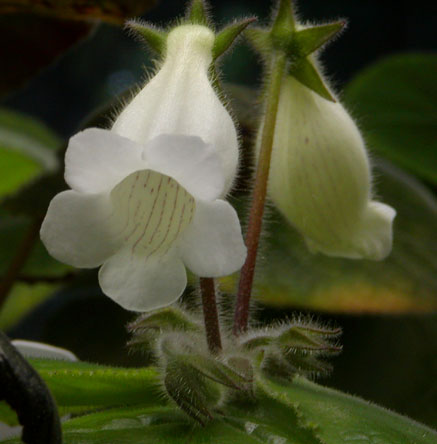
| Species list |
Hybrids list |
Tubers list |
Topics list |
Site index |
What's new |
Home page |
Sinningia richii has recently been rediscovered growing in Brazil's Espírito Santo state. This settles an old problem about the origin of this species, which was otherwise known only from an herbarium specimen in Mexico's Veracruz state, which seemed extremely improbable as the place of origin.
S. richii was known with white flowers; among the new discoveries are plants with yellow flowers and others with purple flowers.
|

|
HistoryFor decades, Sinningia richii was known only in cultivation. Where the plant originally came from was a mystery. There was an herbarium specimen in Veracruz state, Mexico, but this was considered a highly unlikely place to find the species. The only other sinningia found in nature north of the isthmus of Panama is the widespread and adaptable href="4incMain.htm">S. incarnata, a great contrast to the finicky and otherwise invisible S. richii. Growers managed to keep it in cultivation, even without a source in the wild to replenish their collections (the same situation which applies to S. concinna). The plant pictured above was given to me by Bill Price. In 2008, Robson Lopes rediscovered Sinningia richii in the forests of northern Espírito Santo state (Brazil), a much more plausible location for it than Veracruz. Moreover, there were both white-flowered and yellow-flowered forms. According to Mauro Peixoto, these plants were growing in very sandy soil, almost pure sand with a layer of dead leaves over it. [This may or may not be cultivation guideline; on the Paliavana plumerioides page, I warn against extrapolating conditions in habitat to conditions for growing in a pot!] The description below applies entirely to my own plants, so it may not apply to other plants in cultivation or to the newly discovered wild plants. |
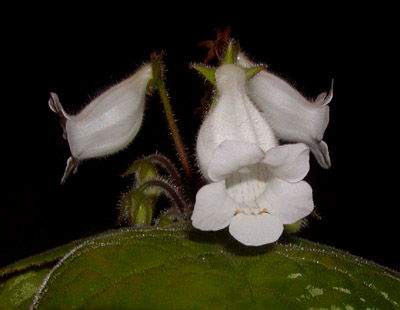
|
LeavesMy plant has three pairs of leaves, which are plain green with no reddish tinge either on the top or the reverse. The largest leaves are about 6 inches [15 cm] long and 4 inches [10 cm] wide, but the pot is small, so the plant presumably could be bigger if grown in a larger pot. InflorescenceIn November 2006, this plant bloomed from the axils of the four upper leaves, in the standard pair-flowered cyme pattern. Although the leaves have no sign of red, the pedicels are dark red, as are the edges of the calyx lobes. When the flower drops and the calyx lobes age, they turn a very dark red. |
CalyxThe calyx is a five-pointed star, and the calyx lobes (particularly the upper three) are spread wide from the corolla. The calyx lobes, all being in the same plane, present almost a flat surface. |
|
HairsThe pedicels, the calyx lobes, and the outside of the corolla are all covered with hairs up to 3-4 mm long. These are longer than the hairs on the leaves themselves. There must be a reason. 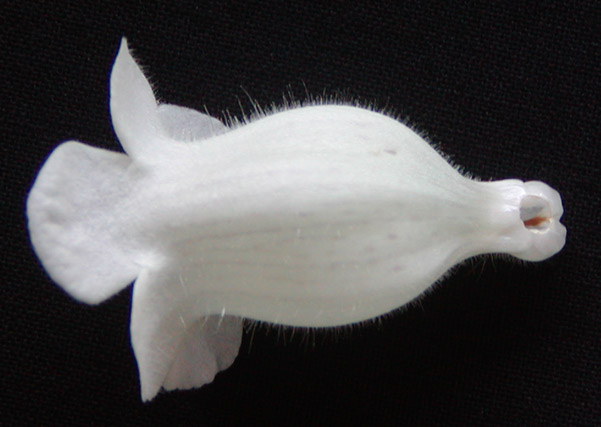
CorollaThe picture above shows the corolla from below. The corolla is just about 2 inches [5 cm] to the tip of the lower lobe. It is tinged with green until it opens, but thereafter is mostly pure white, except for a somewhat shiny greenish "globe" (about 8 mm in diameter) attached to the calyx. The "globe" opens out into inflated pouch with an opening about 1/2 inch [1.2 cm] wide. When fully open, the five corolla lobes are almost in a plane, with only the lower lobe extending a little forward. The lobes are very similar in size, about 1 cm long and 1 cm wide. The width across the face of the flower is about 3 cm. There is a groove in the top of the corolla tube (viewed from outside, a broad ridge about 5 mm wide). The pistil fits into this groove, which keeps the stigma awayfrom the stamens. Four sturdy white filaments spread laterally across the tube in a sideways arc, and hold the fused anthers firmly, so that even if a pollinator pushes the anthers upward, they will would not come into contact with the stigma. |
|
|
There are markings on the bottom half of the interior of the corolla: longitudinal stripes alternating with a string of elongated dots. The color of these markings is somewhere between purple and brown. The markings are mostly confined to the tube and do not extend to the corolla lobes. They are somewhat more conspicuous than in the picture (where they are a little washed out by the flash), but it is likely that they are much more conspicuous to bees, the probable pollinator of this species. White flowers (as in S. eumorpha) are usually "bee violet", reflecting strongly in the near ultraviolet, which is invisible to human eyes but readily perceived by bee eyes. In the picture above, a red object is visible in the opening at base of the corolla. The picture at the right shows the corolla from underneath, cut open lengthwise. In this view, the red object seems to be the rudiment of a fifth stamen, only a few mm long. As in all sinningia flowers, the stamens are attached at their base to the corolla tube, so they fall with the corolla, leaving the female parts of the flower behind. |
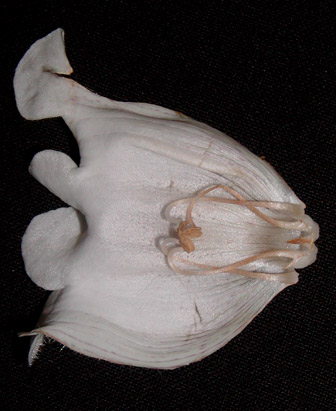
|
Varieties |
|
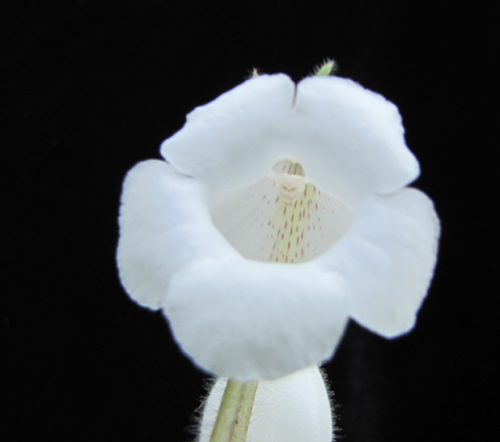
|
The 'Jaguaré' varietyThis is the flower of the variety "Jaguaré", grown from seed from Mauro Peixoto's Brazil Plants organization. [Photograph September 2010.] Compared to the plant at the top of the page, which has since succumbed to the mildew demons, this plant has slightly less yellow in the throat and slightly less pronounced striping. |
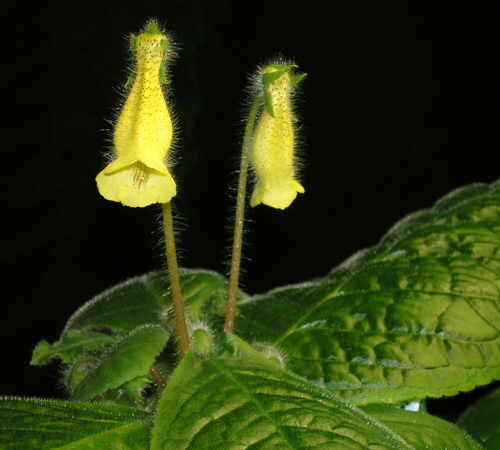
|
The 'Robson Lopes' varietyThis newly discovered form of S. richii has lemon-yellow flowers. There are red spots on the outside of the corolla. Inside the corolla, on the floor of the tube, are three narrow red lines and small red streaks between them. This picture is from Dave Zaitlin, of his own seed-grown plant. Somehow he managed to keep the mildew demon away from his door (see below for my struggles with it). Note the shape of the flower at the right. Then compare it with the flower I got, in the picture below. Mine seems closer in shape to the normal white-flowered S. richii, with a wider but apparently shorter tube and wider corolla opening. |
|
This picture shows the flower I got on my plant, which I acquired in the live auction at the 2009 Gesneriad Society convention in Silver Spring, Maryland (just outside Washington D.C.). This was the only flower it produced, in October 2009, just before it went dormant. At least on this plant, the flower was smaller than that of the normal white variety. (The plant died long ago, and I gave up trying to grow this species.) |
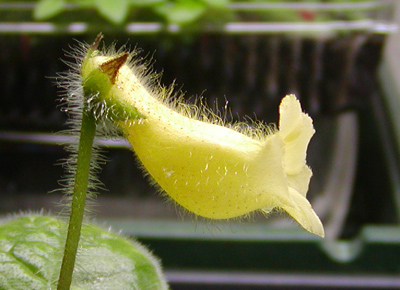
|
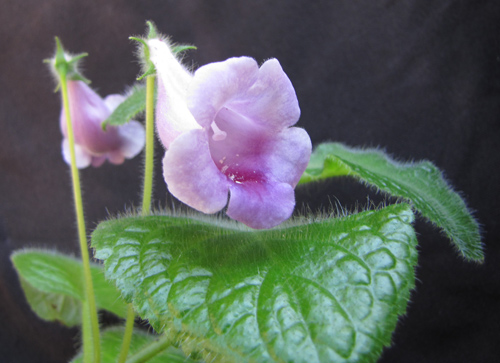
|
The 'Itamaraju' varietyThe 'Itamaraju' variety has purple flowers. Unlike the other varieties of this species, it has indeterminate growth and bears its flowers in axillary cymes of 1-2 flowers. Itamaraju is a town in the southern panhandle of Bahia state. |
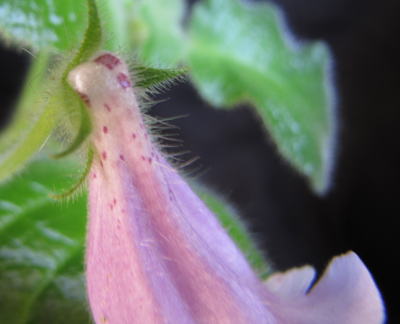
|
The 'Itamaraju' variety has dark purple spots at the base of the corolla. These two pictures were taken in September 2013, of a plant grown from Brazil Plants seed. |
MildewIn 2007 my plants of this species were all attacked by mildew. This was the first time I had had a mildew problem, and S. richii was the first species to get it. August 2008So far, the most effective countermeasure to mildew on S. richii has been washing the leaves with soap and warm water. The leaves still show some damage, but not as much as with chemical remedies, which in most cases destroyed the leaves. However, washing does not prevent the mildew from coming back. Prevention seems to be the only real solution. Both Dale Martens and I have had difficulties with mildew on our plants of S. richii 'Robson Lopes', but so far Dave Zaitlin has been free of it. Update: 2010In the autumn and winter of 2009, mildew took a heavy toll. All my plants of S. richii either died or were severely damaged. Other susceptible plants were also harmed. One was S. barbata 'Tancredo Neves' -- but not the normal green-leaved variety. Culture and PollinationThe plant had five flowers in 2008, but even so I consider it a difficult plant because of the mildew problem. I did not succeed in setting seed on S. richii, either with its own pollen or the pollen of other species in the Corytholoma clade. Dormancy and TuberMy experience with dormancy in the varieties of Sinningia richii has been contradictory. Plants have:
One tuber of the 'Robson Lopes' variety was an elongated, fattened piece of stem with pointed ends. It was about 2 cm long and 8 mm in diameter. Sprouts of this species frequently surface at the sides of the pot, because the underground shoots grow laterally. This suggests that clusters of Sinningia richii found in the wild may not be composed of unique individuals but rather a smaller number of clones, each represented by several plants which have propagated vegetatively. Taxonomic PositionSinningia richii is not particularly close to any other species. It is a sister species to all the rest of the Corytholoma clade. Because of this isolation, hybrids of Sinningia richii are uncommon and, unless the other parent is tetraploid, usually sterile.
Feature table for Sinningia richii
External LinksRobson Lopes, a friend of Mauro Peixoto, found S. richii in the wild and has posted pictures of the yellow-flowered form and the white-flowered form, both in habitat. Mauro Peixoto's web site has pictures of the white-flowered form, the yellow-flowered form, and the purple-flowered form. PublicationSinningia richii was first published by Carl Clayberg in 1968. I don't know who it was named after. | ||||||||||||||||||||||||||||||||